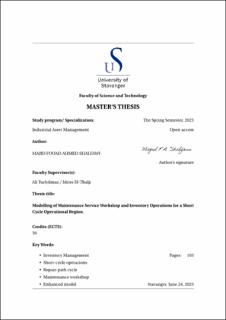| dc.description.abstract | The North Sea region sees a high operational cycle of tools that require frequent maintenance
check-ups, repairs, and preparations for subsequent operations. Given the
quick-paced nature of these operations, the availability of spare parts at the maintenance
workshop is critical for maintaining minimal flowtime. Adding to the challenge
is the practice of sourcing spare parts from best-cost countries, leading to a lead time
of approximately one year, thus necessitating an optimal economic order quantity
and reorder point. The balancing act between maintaining sufficient inventory at
the workshop and managing operational expenses through batch ordering of spare
parts is a complex one. Frequent supply requirements contribute to the environmental
impacts through increased spare part scrap rates. With these challenges in mind,
this thesis aims to develop a simulation model capable of quantifying the costs and
benefits associated with reusing repaired spares, as compared to procuring newly
built spares from best-cost countries. To achieve this, a case study focusing on a
specific maintenance workshop within the North Sea region was carried out. The
comprehensive tool repair and spare part supply operations were conceptualized and
modeled using a simulation approach. Two operational scenarios were simulated:
the first, where the maintenance workshop was completely dependent on newly built
spares sourced from best-cost countries, with no inventory stock dedicated for spares
re-usage. In the second scenario, the workshop primarily relied on repaired spares,
with a safety level of new build stock maintained. The results, guided by the research
question probing the impact of implementing a repair-path cycle process within the
maintenance process, showed that the enhanced model significantly outperformed
the baseline model across several key metrics over a model time run of three years.
These include a 78% reduction in lead times, a 116% improvement in worker utilization,
a 73% reduction in crowding levels, a 52% reduction in scrap rate, and a potential
profit increase of roughly three million NOK (20%). This thesis provides evidence that
the enhanced model, with its focus on repaired spares, presents a more sustainable,
efficient, and profitable solution to the challenges of inventory management in highcycle
operations. It is important to note, however, that the sensitivity of these results
is closely tied to the high procurement lead times. | |
